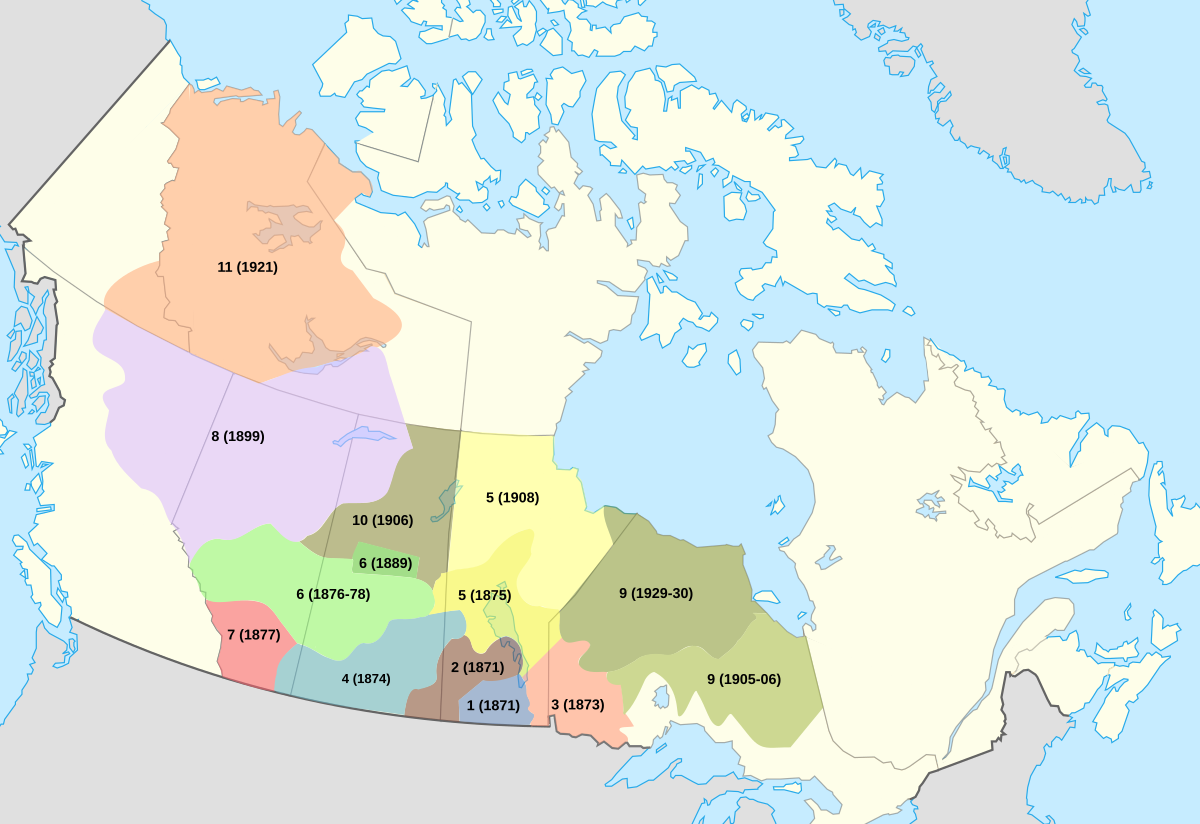Separation of Indigenous People From the Land
A key objective of colonial power is access to land and resources. In Canada, this was done through the signing of treaties. According to the Government of Canada,
Treaties are agreements made between the Government of Canada, Indigenous groups and often provinces and territories that define ongoing rights and obligations on all sides. These agreements set out continuing treaty rights and benefits for each group. Treaty rights and Aboriginal rights, commonly referred to as Indigenous rights, are recognized and affirmed in section 35 of the Constitution Act, 1982 and are also a key part of the United Nations Declaration on the Rights of Indigenous Peoples, which the Government of Canada has committed to implement in partnership with Indigenous peoples (topic 2).
Treaties form the basis for legal rights between the Government of Canada and Indigenous peoples, but the interpretations of treaty rights often lead to disagreement due to different worldviews, the contrast between oral and written cultures, power differentials, and contrasting understanding of the land. According to the Assembly of First Nations (n.d.),
First Nations that signed these Numbered Treaties believed they were entering a trust relationship with the British Crown; First Nations were to share and co-exist with settlers from foreign lands. Therefore, First Nations never agreed to the sale of their lands and resources. Instead, they agreed to share their Indigenous lands, to the depth of a plough (para. 4.1.0).
The province of Alberta lies in the area of treaties 4, 6, 7, 8, and 10 (The Alberta Teachers Association, n.d., p. 1). Being aware of what treaty land one is living on is important, in order to learn more about the history and land.

Although treaty rights are upheld by the Supreme Court of Canada, their interpretation to be a long-standing debate, often stemming from differences in the understanding of land and sovereignty.
According to Turner (2014), one of the fundamental issues is that “the meaning and content of Aboriginal rights is expressed in the legal and political discourses of the Canadian state, and therefore Aboriginal rights exist or have legitimacy only within the Canadian state” (p. 4). This ultimately places Indigenous Peoples in a position of lesser power, as all negotiations are conducted through a Eurocentric lens. As Turner (p. 5) explained, “Herein lies a fundamental disagreement between Aboriginal nationalists and Canadian sovereigntists: many Aboriginal peoples believe to this day that they own their lands, yet the Canadian state continues to assert and enforce its unilateral claims to sovereignty over Aboriginal lands.”
As advancing treaty rights continue to be contested by and interpreted through the courts, many communities and Indigenous scholars and activists are contesting this unequal power balance, the hypocrisy, the discourse of land rights, and the issues of sovereignty. Public awareness, protests, and educating the public on Indigenous rights and treaty rights while advancing acts of decolonization are key. As Alfred (2018, p. 31) argued, “To decolonize, we need to reclaim the sacred spaces of our traditional territories. Rename those spaces to sever the emotional and intellectual ties of colonially imposed names and restore the full histories and ancient significances embedded in Indigenous languages. Reoccupy to create a sense of community and purpose and to regenerate our traditional cultural practices.”
The next page will discuss the movements towards reconciliation, decolonization, and Indigenous resurgence.
References
Alfred, T. (2018). Don’t just resist, return to who you are. YES! Magazine, 85, 31–32. https://www.yesmagazine.org/issue/decolonize/2018/04/09/dont-just-resist-return-to-who-you-are
Assembly of First Nations. (n.d.). Treaties and why they are important. It’s Our Time Educational Toolkit. https://education.afn.ca/afntoolkit/web-modules/plain-talk-4-treaties/1-treaties-and-why-they-are-important/
Government of Canada. (2024, June 26). About treaties. Crown-Indigenous Relations and Northern Affairs Canada. https://www.rcaanc-cirnac.gc.ca/eng/1100100028574/1529354437231
The Alberta Teachers’ Association. (n.d.). ATA – The Alberta Teachers’ Association. https://legacy.teachers.ab.ca/SiteCollectionDocuments/ATA/
Turner, D. (2014). This is not a peace pipe: Towards a critical Indigenous philosophy. University of Toronto Press. ProQuest Ebook Central. http://ebookcentral.proquest.com/lib/norquest-ebooks/detail.action?docID=3268327.
Image Credit
Figure 1: Numbered treaties map by Themightyquill, CC BY-SA 2.5.
The rights set out in treaties between the federal government, the British Crown, and Indigenous Peoples. The rights are constitutionally protected.
Collective rights based on Indigenous Peoples’ occupation of land in what is now Canada since time immemorial.
Viewing Western European culture as the norm and superior to other cultures and worldviews. Foundation of colonization.
Challenging colonial systems of oppression and privilege and reclaiming Indigenous self-determination.
Movements to reclaim Indigenous ways of being and knowing, advocate for self-determination, and resisting settler colonialism and oppressive colonial policies. Part of the process of decolonization.

